Additive manufacturing, more commonly known as 3-D printing, is an emerging technology with the potential to change how manufacturers produce their wares. Industry insiders have also praised 3-D printing as a method that may positively impact manufacturing processes’ environmental effects. As with any new technology, however, it’s important to take a critical look at possible additive manufacturing environmental impacts.
Additive manufacturing is still a young technology. According to a EurekAlert! article, the process certainly has the potential to change the way manufacturers impact the environment. There is, however, a caveat: According to the journal, even after extensive research, it is simply too early to tell if additive manufacturing is a step in the right direction for sustainable production.
While it is unclear if manufacturers will be able to use 3-D printing in an environmentally responsible way, certain aspects of the process lend it to such ends. According to an article in Yale’s Journal of Industrial Ecology, these factors include:
- Supply chain minimization — While researchers have not thoroughly studied additive manufacturing’s impact, there exists incredible potential for an environmental impact reduction due to its ability to reduce the number of stages in any given supply chain.
- Manufacturing localization — Due to this potential for supply chain minimization, more localized production could also be possible. Localizing production can lead to lower environmental costs in terms of shipping and receiving manufactured products.
As with any other new technology, those who plan to use additive manufacturing in environmentally sustainable ways will also need to examine the challenges the process can present.
- The unknown — At this point, it is still unclear what additive manufacturing will look like in the future and how successful it could be.
- The implementation — Additive manufacturing may become a substitute for today’s manufacturing technologies, or manufacturers may choose to use it in a complementary way. Implementation will likely have far-reaching effects on 3-D printing’s environmental impacts.
- The evaluation — Gathering data on and evaluating any new technology can take many years. It may remain impossible to determine additive manufacturing’s environmental impact until manufacturers have had more time to hone and utilize this technology.
For manufacturers who have taken a stand when it comes to environmental impacts in their own facilities, it will be important to analyze the entire production process’ life cycle at present and compare it to outcomes resulting from implementing additive manufacturing. From sourcing raw materials to processing, printing, as well as using and disposing of final products, manufacturers must consider all steps when measuring process and product sustainability. While manufacturers can use additive manufacturing to create almost anything, knowing whether this process will help them go “greener” remains to be seen.
